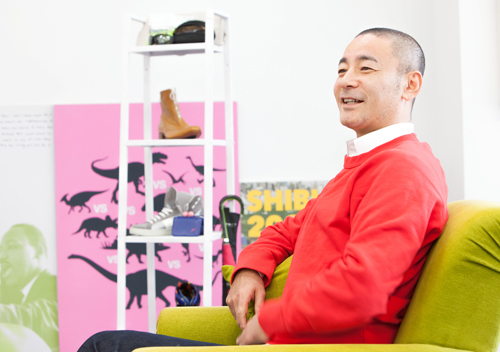
from Japan vol. 63 2013.05.09 A society as a melting pot for the minority and the majority - The "People Design" concept
![]()
- Becoming involved opened a whole new world of welfare
- The “stigma” able-bodied and disabled people all face
- Designs that help tear down emotional barriers
- Creating a diverse city
- A communication charm that represents one’s support
- Worlds melt together around the concepts, “fun” and “cool”
- People Design x Movie
- Creating a new social atmosphere
“Hello. Does anyone here have friends with the last names, Suzuki, Takahashi, Tanaka, or Sato?” Almost everyone raised his or her hands in response to this question.
“And how many of you here have friends who are physically or mentally challenged?” Many people who had raised their hands lowered them.
Currently there are 7 million people who have one of the “top 4 most common last names in Japan.” And there are 7.3 million people in Japan who have been issued disability certificates. This means that under normal circumstances, there would be around 2 or 3 people with disabilities in each classroom, but in reality able-bodied people hardly have any contact with the disabled.
I spoke to Mr. Shinji Sudo, the president of NEXTIDEVOLUTION and chairman of the People Design Institute who is committed to helping realize a diverse society, where people with amazing individualities can melt together, regardless of whether they have a disability or not, through fashion and design.
目次へ移動 Becoming involved opened a whole new world of welfare
Mr. Sudo always asks, "How many of you here have friends who are physically or mentally challenged?"
Mr. Sudo has 3 sons. It was 17 years ago that his second son was born with severe cerebral palsy. Until then Mr. Sudo worked in the glamorous world of fashion, design, and advertising. But when he became personally involved, his first impression of this new world he had entered was that it was very "somber" and "dark"... And as he and his family began receiving welfare services from the government, he felt how strange it was that "in Japan, the worlds of able-bodied people, and that of people with disabilities were completely separate."
The glamorous, fashionable world of the past and this new non-glamorous world he had never imagined before. He wanted to completely transform this somber bleak world of welfare! And he believed that the know-how and experience he had gained in fashion, design, and business would certainly be advantageous.This is how the "NEXTIDEVOLUTION" began.
 The name, NEXTIDEVOLUTION is comprised of 3 words, next, tide, and evolution. A presentation of this project is available on its website.
The name, NEXTIDEVOLUTION is comprised of 3 words, next, tide, and evolution. A presentation of this project is available on its website.
"At the 10-month checkup, we learned that our son had level II cerebral palsy. The doctor told us then that he would never walk. It was as though someone had turned off the lights, and I felt like my world had turned pitch dark. But couple months after that, I began to believe and to have groundless hope that someday my son will be able to walk," said Mr. Sudo laughingly.
Every night or early morning when he got home, he would sit next to his sleeping son and imagine him running up the stairs. When his son turned 2 and a half, "He suddenly sat up. I was very busy at the time, but miraculously I was home when this happened. I thought then that life was all about witnessing moments like these." He felt great joy and appreciation for something that should be quite ordinary.
"When I thought about the future of my child as a father of a child with a disability, I thought about how people with handicaps would be able to live independently. Regardless of whether a person has a disability or not, if society became a great big melting pot, where it was normal for all kinds of people to intermingle, then I thought my son would be able to go out there and live independently even when we are gone."
目次へ移動 The "stigma" able-bodied and disabled people all face
Here is another question.
"When you hear about people with disabilities or handicaps, how does it make you feel?"
Many of you may feel as though it is something special, or "you may not know how to interact with such people." This knot you might feel in your heart is what is referred to as a "stigma." On the other hand, people with disabilities may worry about "being able to get on the train by themselves" or about "being stared at." This, too, is a stigma. Able-bodied people and disabled people both experience stigma. So from what does it arise?
In Japan, able-bodied children and children with special needs study separately, in different classrooms.
And when a person in a wheelchair boards a trains in Japan, 3 station attendants help the person on board while the following announcement is made: "There are customers boarding the train." But in North America and Europe, it is quite commonplace for people standing nearby to offer a hand. One man might ask a student standing next to him to get a hold of the other side, for example.

In Western societies, it is quite normal for people nearby to offer a helping hand. (iStockphoto® DaveAlan)
At a glance, it seems as though Japan has become quite barrier-free and there is sufficient welfare support from the government. But will getting rid of the physical bumps and barriers help make the "stigma" we are all experiencing disappear? Until now, welfare was structured so that the disabled were separated from the able-bodied and were given special treatment. But this prevents these 2 groups from having hardly any interaction, so we don't know how to interact with one another. Mr. Sudo believes that this is what is at the root of the "stigma."
How can we create a diverse society?
"First of all, we need to break down stigma the minority are experiencing. One example of this are mothers of small children who may want to go watch a movie, but refrain from going because their children would be loud and they might bother other guests. This kind of feeling is what we want to get rid of. It is ok even if the children might be a bother. We need to create an atmosphere where we all help each other. Or work together with NPOs that help create children's playgrounds so that babysitting facilities can be created in foyers of movie theaters, and so on and so forth."
"What is important is to resolve each stigma and problem the minority are facing, and to have them come and play with us (majority) in our field. This is the kind of movement I want to create."
As a first step, we need to create an environment where the majority and the minority can mingle and create more opportunities for interaction. With the next 10, 20 years in our sights, we need to develop methods and measures that will resonate with youth, who will one day become fathers and mothers, and with their children. Designing such methods and measures will help create a society with a whole new atmosphere and values. And this will help strip away the "emotional barriers."
目次へ移動 Designs that help tear down emotional barriers
Products and activities designed to "strip away emotional barriers" will help people realize many things anew, and thereby encourage people to "act" and create new "movements." This entire chain of action is the concept of "People Design." "People Design" uses fun, entertaining mediums such as fashionable products, movies, and sports that can overcome stigma to address complex needs and issues of both the minority and the majority.
Here are some fashionable products and events created based on the concept, "People Design."
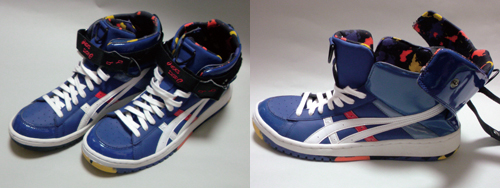 Jeff Staple, world-class artist and creator who lives in NYC, served as the creative director for these sneakers developed in collaboration with ASICS and NEXTIDEVOLUTION. (Photograph by: NEXTIDEVOLUTION)
Jeff Staple, world-class artist and creator who lives in NYC, served as the creative director for these sneakers developed in collaboration with ASICS and NEXTIDEVOLUTION. (Photograph by: NEXTIDEVOLUTION)
For example, take a look at these sneakers. They look like an ordinary pair of fashionable basketball shoes. But you will be surprised to hear that these hip shoes actually come with various functions that are really useful for people with disabilities.
Conventional shoes that have been universally designed or designed for people with disabilities did not have shoelaces because they are hard to handle. But the designers wanted to leave the shoelaces in tact because they are what make sneakers cool. So these shoes have been designed to open up wide like ski boots to make it easier for people with disabilities to put them on and off.
The ankle straps can be rotated around the fastener on the heel, letting users customize the direction in which they wrap around the ankle. Usually these straps are firmly attached so that they wrap around your ankles from the inside out, but these straps can be arranges so that they wrap around towards the left, making it easier for left-handed people and people who do not have full use of their right hand to manage.
This video shows you how to change the straps and take the shoes off.
These shoes were sold at popular stores in Shibuya and Harajuku, and featured in numerous fashion magazines. Many fashion savvy people were quite taken with these sneakers because the way you put them on and took them off was "different and fashionable." There is no stigma when young people choose shoes because they like the design.
"I want people with disabilities to come out to Shibuya and Harajuku to buy these shoes, and shop around for other fashionable stuff while they're out there. I want to create an environment where people with different individualities can come and hang out together in fashionable parts of the city. We see this already happening with respect to race. In the past, this wasn't the case, but don't you think it's become quite commonplace to pass by foreigners in Shibuya and Harajuku?"
目次へ移動 Creating a diverse city
March 16, 2013 was beautiful sunny day. The "TOKYO OUTDOOR WEEKEND" was being held at the Yoyogi Park in Shibuya. Over the past few years, outdoor festivals featuring fashion and music have become quite popular. This event was held to introduce "new ways to enjoy the outdoors." Outdoor products, clothing, and a wide array of various other items were introduced in the booths, and the music from the DJ booth rang clear across the spring skies and helped liven up the event.
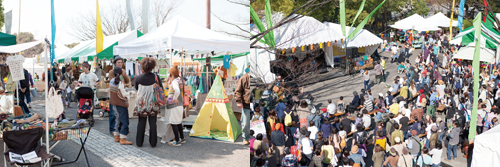 Many youths as well as families with children came to enjoy the event.
Many youths as well as families with children came to enjoy the event.
At this lively event, a talk show about "building a new city starting in Shibuya" with Mr. Ken Hasebe, a member of Shibuya's ward assembly and Mr. Sudo was held. Mr. Hasebe is also the representative of "Green Bird," a cleaning project that started in Harajuku and Omotesando believes that "A clean town also makes people's hearts and minds clean."
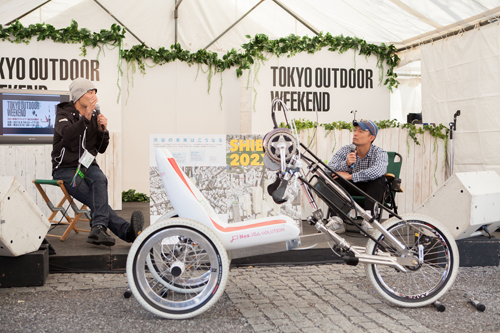 The talk show was held amid a very frank and casual atmosphere. A handcycle was exhibited in front of the stage.
The talk show was held amid a very frank and casual atmosphere. A handcycle was exhibited in front of the stage.
"My hometown is Harajuku and Omotesando, but it had started to feel as though Harajuku and Shibuya had begun to loose their energy," said Mr. Hasebe, who had felt as though the words "Shibuya and Harajuku" had begun to appear less frequently in magazines. When he was thinking about what it means for a "city to be cool" he came across Mr. Sudo's ideas about the "society as a melting pot" and a "diverse city" and felt that they had a lot in common.
According to a research conducted by the software company, Adobe, involving 1,000 youths each from the UK, USA, France, Germany, and Japan, so a total of 5,000 youths under 18, 30% of the respondents listed Tokyo as the "coolest city" in the world. And Mr. Hasebe believes that Shibuya is a very important area of Tokyo for sharing information with foreigners.
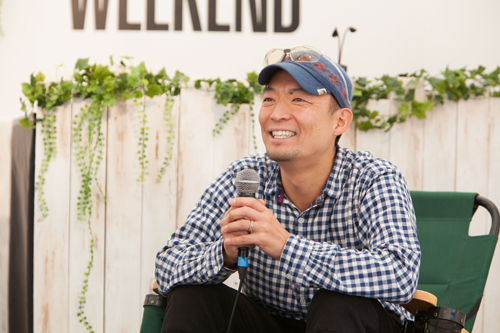 Mr. Hasebe explained, "I think that when people with disabilities begin hanging out in cities and become part of the scene in Shibuya and Harajuku, the atmosphere will begin to change for the better."
Mr. Hasebe explained, "I think that when people with disabilities begin hanging out in cities and become part of the scene in Shibuya and Harajuku, the atmosphere will begin to change for the better."
"People who live in Japan may not notice, but Shibuya is a very attractive city for people living overseas. So if we add the element of a "diverse city" to Shibuya to appeal to people across the world rather than people in Japan, then we can amplify our power of global communication," said Mr. Sudo.
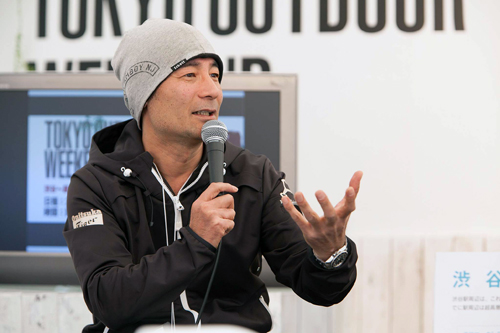 "Shibuya is a very attractive city that has the power to show the world that this new value, a melting pot for abled-bodied and disabled people, is a cool culture."
"Shibuya is a very attractive city that has the power to show the world that this new value, a melting pot for abled-bodied and disabled people, is a cool culture."
目次へ移動 A communication charm that represents one's support
In order to transform Shibuya into a "city that serves as a melting pot for diverse individuality" regardless of whether people have disabilities or not, Mr. Sudo and Mr. Hasebe worked together to develop the "communication charm."
This charm features straightforward words and graphics for "excuse me," a conversation starter, and icons for different objectives like the toilet, hospital, train station, and help, and lastly an icon for "thank you."
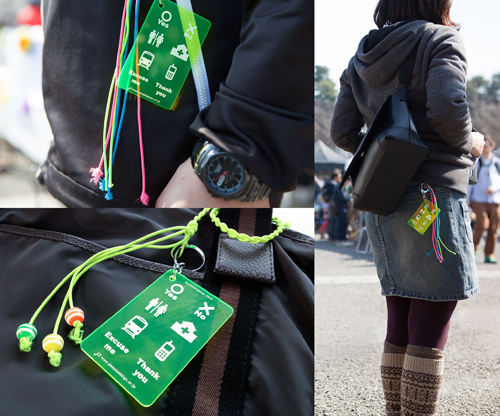 These communication charms may be attached to bags or clothes as an accessory. (Photograph by: NEXTIDEVOLUTION)
These communication charms may be attached to bags or clothes as an accessory. (Photograph by: NEXTIDEVOLUTION)
This charm will serve as a representation of your willingness to help. By wearing this charm you are saying, "If there is anything I can help you with, please don't hesitate to ask!" "Whatever you need, I'd love to help!" and "I wholeheartedly support people with disabilities!" But it would be a shame if they promoted the charms, but the people who it's meant to touch don't know that the charms exist or what they mean. They have been developed by designers of international brands who have shops in Omotesando and are being manufactured by people who come to work in the 4 welfare workshops in the Shibuya Ward.
You can purchase these charms at multi-designer retailers like "SHIPS" in Shibuya and Harajuku and in shops in Harajuku popular for its Gothic & Lolita or Kawaii fashion. Asobi System, the management office of Kyary Pamyu Pamyu, a famous Japanese singer and fashion leader, and actor Jun Kaname also support these charms.
Mr. Hasebe explained, "Having one of these charms has made me realize just how many people could use help. And it makes me feel more proactive in offering help."
I am sure many of you feel shy and reluctant about offering help when you see someone that is visually impaired or in a wheelchair. But Mr. Sudo believes you can overcome such barriers with the help of these stylish charms or fashion, and "Shibuya," a globally popular city, can also play a key role.
目次へ移動 Worlds melt together around the concepts, "fun" and "cool"
At the "People Design Institute" booth organized for the TOKYO OUTDOOR WEEKEND, people could purchase communication charms and also test ride a handcycle. Many visitors stopped by the booth to take a closer look.
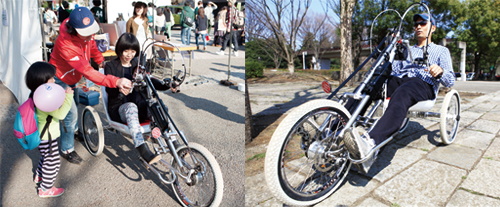 Test riding a power-assisted handcycle. Many people, young and old, had a go. They said it was "Very interesting!" and "It's faster than I thought!"
Test riding a power-assisted handcycle. Many people, young and old, had a go. They said it was "Very interesting!" and "It's faster than I thought!"
"The handcycle started out as a vehicle for people in wheelchairs so that they may get around by using only their upper limbs. Of course, initially it was thought of as a welfare equipment. But it has now become a stylish city cycle. In the 70's we saw a big car trend, in the 80s a motorcycle trend, and in 2000 we witnessed a bicycle trend. And if all of us began riding handcycles as though it was the next big trend, helping handcycles become more widely available, then this will help drive prices down. Then people who really need these handcycles can ride them into town not as a medical equipment, but as a stylish vehicle. I think this will help get things moving along, too.
Although the handcycles may be highly functional, if they become widely recognized for its stylishness, then People Design will have succeeded. It will be as though a cool vehicle has also happened to help provide a solution for a social issue. Listening to Mr. Sudo describe the scene, I could picture young girls or older gentlemen riding through the streets of Shibuya on handcycles. Whether people have disabilities or not is irrelevant. They are simply hanging out in the same environment, having fun.
"I think this is what it means to become normal."
At the TOKYO OUTDOOR WEEKEND, the People Design Institute arranged for people who work in welfare workshops in Shibuya to take part as part of an on-site training program. The event organizers Earth Garden, an LGBT organization "Queer & Ally," and people from Green Bird all worked together as event staff and cleaned the venue and the surrounding area.
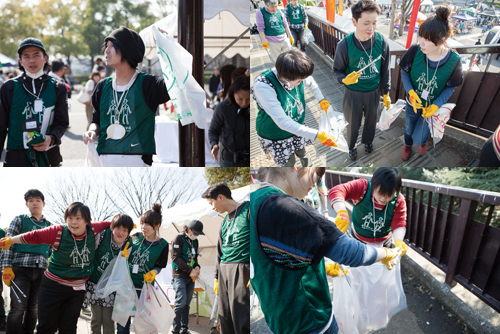 Participants worked together to clean up the city. They enjoyed one another's company while they picked up rubbish.
Participants worked together to clean up the city. They enjoyed one another's company while they picked up rubbish.
This "environment where worlds melt together" that Mr. Sudo described was in reality a very friendly and fun-filled environment.
目次へ移動 People Design x Movie
Identifying with NEXTIDEVOLUTION's activities and the ideas of People Design many companies have joined the movement. "feels" is an event that allows able-bodied and disabled people alike to come and enjoy the movie, "Tokiwo Kakeru Shojo (The Girl Who Leapt Through Time)," to feel the movie with their bodies. This was the 6th showing, and it was held at the Pioneer showroom in Ginza in collaboration with Pioneer and NEXTIDEVOLUTION.
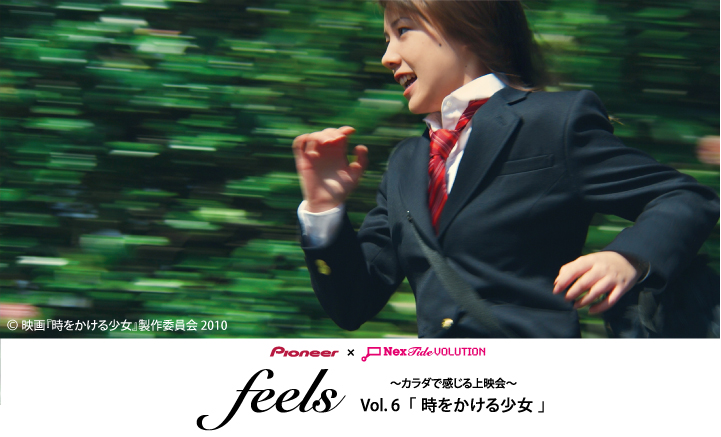 (Provided by: NEXTIDEVOLUTION)
(Provided by: NEXTIDEVOLUTION)
In order to help people with visual impairments enjoy movies, NEXTIDEVOLUTION provides audio guidance that explains what is going on in the movie. There have been movies with audio guidance before, but only movies that were a few years old were available. And because the audio guidance was integrated as part of the movie data, even people who didn't need the audio guidance had to listen to them.
That is why NEXTIDEVOLUTION decided to transmit the audio guidance via FM waves so that only people who needed it could listen to it. This made it possible for visually impaired and abled-bodied people to enjoy watching a movie in the same environment.
When the movie, "The Girl Who Leapt Through Time," first premiered in 2010, the audio guidance was made available at movie theaters in Shinjuku, Ginza, and other areas, allowing able-bodied and disabled people to watch the movie together.
A movie trailer of "The Girl Who Leapt Through Time" with audio guidance.
This most recent event held in collaboration with Pioneer featured not only NEXTIDEVOLUTION's audio guidance, but also seats equipped with Pioneer's "audio sensory system", which let viewers feel the sound. These activities will gain new momentum as NEXTIDEVOLUTION welcomes Italian automobile manufacturer, Alfa Romero as a new partner for the next fiscal year.
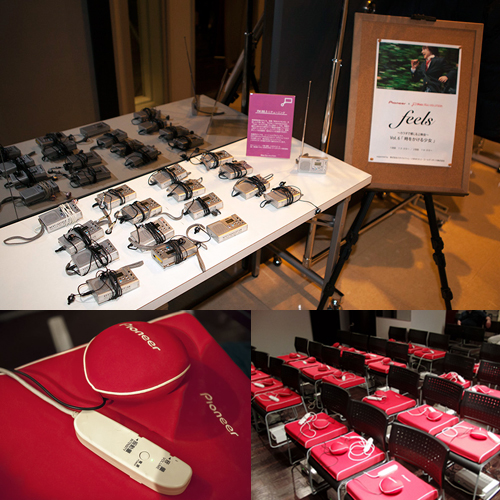 Top: Viewers could borrow FM radios for free at the showing. Goldendance Co., Ltd. provided these bone conduction earphones.
Bottom: Pioneer's audio sensory system. You can sit on these cushions or lean back on them, and the vibrating pouches can be placed anywhere you like.
(Bottom right: NEXTIDEVOLUTION)
Top: Viewers could borrow FM radios for free at the showing. Goldendance Co., Ltd. provided these bone conduction earphones.
Bottom: Pioneer's audio sensory system. You can sit on these cushions or lean back on them, and the vibrating pouches can be placed anywhere you like.
(Bottom right: NEXTIDEVOLUTION)
This "audio sensory system" was originally developed when Pioneer's founder, Mr. Nozomu Matsumoto, heard Professor Hideo Itokawa say back in 1972 that "When we listen to music, we are not only listening to the sound waves with our ears, but we are also listening through bone conduction. In other words, we listen to music with our ears and feel it with our bodies." Thinking that with the help of this special acoustic system people who are hearing impaired could also start enjoying sounds and rhythms, Pioneer began hosting the "Listen Through the Body Concert" in 1992 as part of its CSR program.
I tried the system. When the door slams shut, for example, the cushion underneath instantly vibrated. It really felt like the door slammed shut hard, and that took me by surprised.
Pioneer holds approximately 30 "Listen Through the Body Concerts" in collaboration with welfare facilities and local governments. The operations are handled by the office staff and the employees who have volunteered their time and their families. We asked Mrs. Sakura Yamashita, who works at Pioneer's Listen Through the Body Concert, Office about their activities.
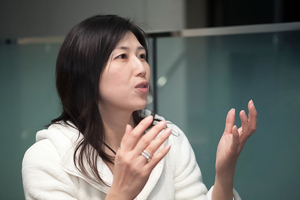 Mrs. Yamashita explained, "What has supported these activities for over 20 years is our employees."
Mrs. Yamashita explained, "What has supported these activities for over 20 years is our employees."
"Many people who volunteer say, 'It doesn't feel as though we are doing something for them. Rather, it's more like they are giving us something.' There have been people who experienced our audio sensory system who have cried with joy that they were able to hear. Volunteers who shared such moments say they were very inspired."
There has been volunteer staff that after having volunteered began to take interest in supporting people with visual impairments. They studied Braille and took initiative in creating Braille brochures for these activities.
Mrs. Yamashita also has a family member who has a disability.
"Ever since I was little, I would feel people staring, how they looked at people with disabilities."
She used to not like how hardly anyone with disabilities came out to town and the way people looked at the disabled.
"I have always wished, since I was young, for prejudice towards the disabled to disappear. Like Mr. Sudo, I hope that society will become one big melting pot, so it would give me great pleasure to be able to create a place of recreation where all people and even children, with or without disabilities, can come together to have fun."
I spoke to some people who came to watch the movie. Mrs. Yuka Ohori lost her eyesight in an accident when she was 22 years old. She said, "The audio guidance helped me imagine very clearly what the scene was like. I hope people who can see will also experience this."
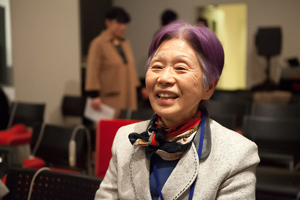 Mrs. Ohori who watched the movie me, "I had a great time. I hope to come to Ginza again."
Mrs. Ohori who watched the movie me, "I had a great time. I hope to come to Ginza again."
Mrs. Ohori, who lives with her guide dog, says that the shift toward barrier-free has gotten rid of so many of the bumps in the road that it has actually become harder to navigate at times because when she goes on a walk with her guide dog, he doesn't stop to warn her about a crossing unless there is more than a 2cm height difference between the sidewalk and the road. Making things barrier-free has solved some issues, but it also has given rise to other problems.
目次へ移動 Creating a new social atmosphere
People have different kinds of disabilities; they may be physical or mental. The kind of disability and the level to which they are affected vary significantly. And when we look at the world from a wider perspective, from the perspective of diversity, you begin to realize that although there may not be that many people, and their impairments may not be medical, they are affected by a disability nonetheless. For example, women who may be pregnant are restricted temporarily from doing things they normally would do, the elderly, and the lesbian, gay, bisexual, and transgender community are minorities in our society. All of us will age one day, and join the elderly community. And when you think about this, we will one day become disabled, a "minority that faces many issues."
Social atmospheres and values are created and change very slowly. But Mr. Sudo will continue to imagine what his son will be like in the future.
"I always imagine a life where all 3 of my sons are living independently, whilst helping and supporting each other. They even have kids of their own. Of course my second born is also independent and living in the same society. That's the kind of life I picture."
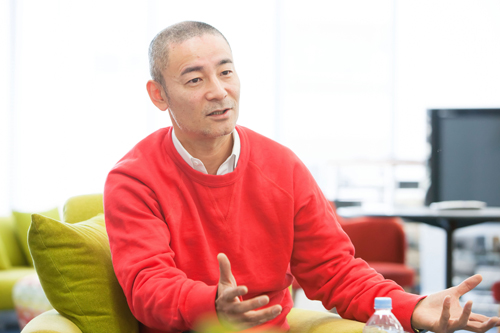
"No one used to really think about environmental issues and global warming as serious issues, but now, everyone hears about them quite often. The concept of 'diversity' is also spreading gradually, and we are beginning to see a society that is beginning to melt together. One day, society will become more tolerant towards the minority who have a disability of some kind, and it will become quite normal for people to offer their assistance proactively. "
When such a day comes, you may look back and remember today as the "day everything started." Perhaps we are at a turning point, where we shape new values for the future.
Related URL
NEXTIDEVOLUTION
http://www.nextide.net
People Design Institute
http://www.peopledesign.or.jp
Green Bird
http://www.greenbird.jp/english/
Listen Through the Body Concert (Japanese Only)
http://pioneer.jp/citizen/karadadekikou/
Report by: Tomomi Hasebe (Think the Earth)
Photographs by: Ken Shigematsu, Yu Iwasaki
Translated by: Yuri Morikawa (oxygen inc.)















